«I only cook with what I see», he says: tall, bearded, long-haired, a Flemish man with Viking features, innate sensitivity, and a warmth that touches the heart—though alas, not the limbs, which would have been quite helpful in recent days while walking along the strand caressed by the North Sea. This endless sandy strip, which in summer, under milder temperatures, fills with bathers sheltered in their strandcabines—those picturesque little wooden huts, often painted in bright colors, dotting the beaches of Northern Europe—seems so odd to us Mediterraneans (but what are they for? Come here, and you’ll understand). We are in the town of Koksijde, West Flanders, Belgium, just minutes away from the better-known Ostend—a name steeped in old-world charm yet scarred by the wounds of World War II. Before the bombings laid waste to an enchanted and now vanished world, the seafront was lined with magnificent Belle Époque hotels, a chic destination for Northern Europe’s privileged classes—especially the British—who, in the 19th and early 20th centuries, believed they should avoid sun exposure and take baths only in the ocean, never further south.


Strandcabines in Oostduinkerke, near Ostend. (Photo: Visit Flanders)

A view of Ostend (Photo: Visit Oostende)
But now we are in Koksijde, in a countryside house dating back to 1832 at Pylyserlaan 138, complete with a large garden oven and smoker. It’s a
non-restaurant. And it is the soul-place—a kind of Benelux-style
Macondo—of
Willem Hiele, the Viking mentioned above. Born in 1981, he is a chef whose current address is a bit further away, at number 83 of the 50Best.
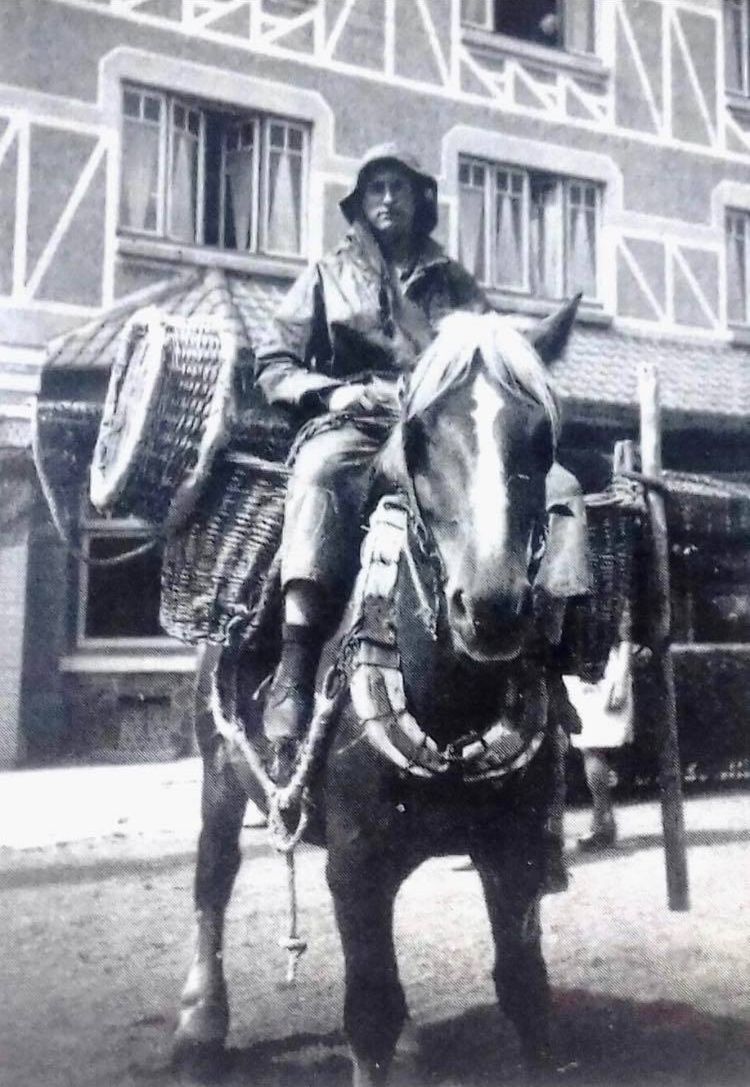
Grandfather Jerome, a fisherman

Horseback shrimp fishing on the Ostend coast. (Photo: Westtoer APB)
This house in Koksijde was first and foremost the home of his grandfather
Jerome, a fisherman, once the common profession in the area. Here, after a stint as a baker and surfing the seas of the world in search of the perfect wave, young
Willem decided to return and open his restaurant—not boasting a particularly stellar culinary pedigree or famous mentors but with the intention to «cook only with what I see», as we’ve heard. What he might have seen most clearly at first becomes evident when we chat with old
Stefaan Hancke, a colleague and friend of grandfather
Jerome. Blue-eyed
Stefaan is a jovial type who loves jokes and laughter, seemingly at peace with the world: «If you don’t like shrimp, eat cabbage!» he exclaims at one point while we stroll through his Oostduinkerke farm, admiring the imposing Brabant Draught horses sheltered in the barn. We’re not experts, but we’d guess: draft horses? Correct. They’re used to perpetuate an ancestral rite from these parts, nearly extinct (question: is it now just a tourist attraction?), namely shrimp fishing on horseback in the adjacent sea, which Unesco inscribed as Intangible Cultural Heritage of Humanity in 2013. We’re told that only 14 fishermen still practice it, and just eight do so professionally.

Fisherman Stefaan Hancke stands by the cauldron where he cooks the horseback-caught shrimps

Willem Hiele at Stefaan Hancke's fishing hut
Unfortunately, the weather is bad this afternoon. The issue isn’t so much the rain but the wind and currents,
Stefaan explains, so the horses had to stay indoors, sheltered (these equines deserve respect. When asked about the biggest challenge of this ancient practice, the elderly fisherman begins: «You need a good relationship with the horses because they’re certainly not used to going into the sea». It’s hard to keep them steady in the surf, despite their sturdy legs, while pulling the cart where freshly caught shrimp are piled up. He says other things lost in my notebook, but you get the idea of the main theme).
We console ourselves, though: the morning catch, before the rain, was quite fruitful—three kilos of the freshest shrimp. «This is the best season to catch them; they’re big and meaty, born between February and April, giving them time to grow». They appear grayish at first, which might seem unappealing to those familiar with larger, red Mazara shrimp, but here it’s a sign of quality. These northern crustaceans have five pigments: when first caught in the nets, they appear gray (hence their name, grijze garnalen); after being boiled in salted water, they turn reddish, then orange as they dry, if they’re really good. On the plate, they’ll look white to our taste buds—that’s how it works. They’re small, no more than three centimeters; fragile; and impossible to freeze, as they would lose their structure and flavor. Ostend boasts: “Best shrimp in the world.” Why? "«hey feed on plankton, which is ideal for them. Secondly, we hand-sort the catch 100%—woe to any unsuitable shrimp (damaged and thus bitter). Lastly, we cook them in seawater and let them cool in the open air, not in water as they do on boats, preserving the aroma». (Our palate agrees: they’re elegant, less salty than our local shrimp, reflecting the salinity of their waters). There’s a small tourist economy around the grijze garnalen, the star of the local dish, garnaalkroketten—gray shrimp croquettes—celebrated with an annual Garnaalkrokettenfestival that attracts croquettelovers from across Europe.
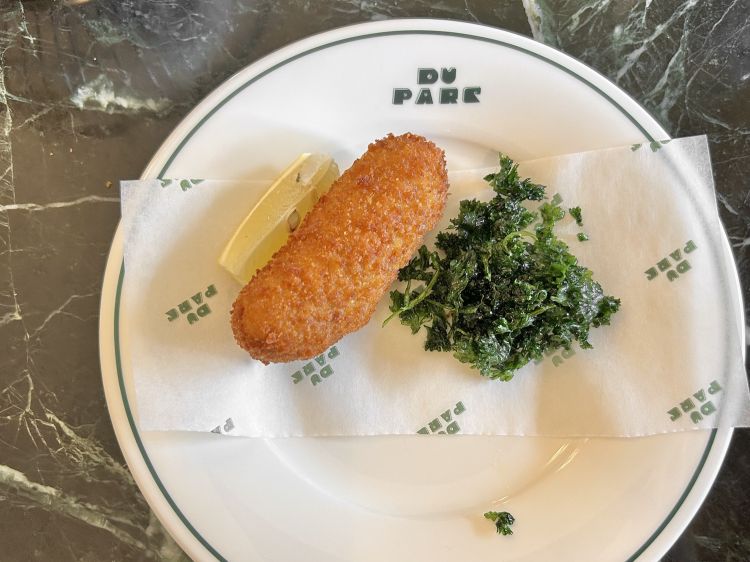
Garnaalkroketten (shrimp croquettes) served at Brasserie Du Lac
Unsurprisingly,
Willem Hiele’s most famous dish also features gray shrimp. A dish of memory: a shrimp soup he calls bisque, evoking family meals. We ask: is it your signature dish? He replies: «No, it’s a destination dish», an iconic dish he wants to move beyond to grow. He offers it only at special dinners, by reservation, in his grandparents' old house—not at his new restaurant. Since 2022, the chef has moved to a different location, a stunning building in the Oudenburg countryside outside Ostend. For us, it’s a mistake, and we’ll say it because this incredible broth fills the soul, evoking an almost anthropological connection to a timeless bite with so much to tell (we sense it too, even though we come from another culture). The peeled shrimp—there’s a whole technique to it; grandma
Vermote could do it in a second—serve as a side to a superlative shrimp bisque in a cup, made from the concentrated broth of the shells. It's rich and enhanced with brandy-infused Bressac cream, sprinkled with coffee to complete the circle, like a cappuccino perfect for dipping crispy, naturally leavened bread (
Hiele was born and raised a great baker; we’ve mentioned this before: «I didn’t feel like studying, so my dad sent me to work in a bakery. He thought it was punishment, but I loved that world, and it shaped me»). The bread is stuffed with the same shrimp, lightly seared, and clarified butter that includes a percentage of fat from salted and dried white cod. The taste is simply sublime.
For fine dining, it’s admittedly a tricky dish to handle; stains on the tablecloth are always a threat. Hiele reassures us: «By the end of the tasting, the table has to be messy».

Willem Hiele's shrimp bisque
We’d cherish this moment of historical, social, and territorial connection (as for the stains: it’s always good to
épater le bourgeois) in the
new restaurant with rooms by Willem Hiele, an incredible oasis in the flat, green expanses of rural Flanders. It’s located in a brutalist gem from 1971, designed by Belgian artist and architect
Jacques Moeschal, in the beautiful countryside of Grote Keignaert—a nature reserve just a few kilometers from the city and a spectacular polder, meaning a stretch of sea reclaimed through dikes. Surrounding it are eight hectares of land dedicated to farming (herbs in particular), raising livestock (the landscape is dotted with cows), and spontaneous blooming, which, according to plans, will soon envelop the restaurant in a fine yet wild, multicolored beauty. «The clean lines, raw concrete, and views of the fields inspire me to get closer to the essence», says
Hiele. «And so, I serve a piece of mackerel fresh out of the smoker—no sauce or unnecessary embellishments. Those who try it are struck by its simplicity».

The building of Willem Hiele's new restaurant

A brutalist gem from 1971, designed by Belgian artist and architect Jacques Moeschal
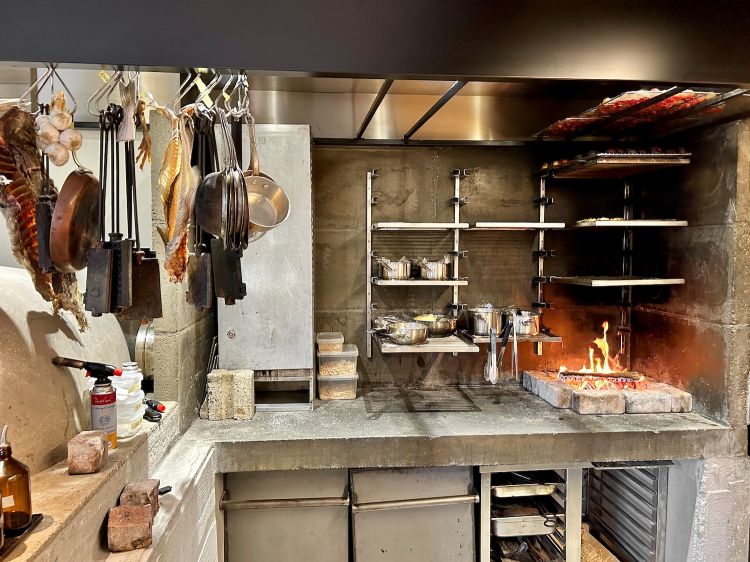
The open kitchen, featuring fire and embers
«I cook only with what I see»,
Willem said early on, and this is a bit of a thread running through the story. So, shrimp, first and foremost. Then oysters, haddock, mackerel, and vegetables from a farm just a few kilometers away. Local berries to bring acidity to the dishes, although here
Hiele sought a little help—lemons arrive from a biodynamic farm in Spain. Not that acidity is lacking on its own: «Even the figs here are a bit tangy because they grow near the North Sea». He adds: «We have a dill plant in Koksijde. We already know: one week after it blooms, the first asparagus will sprout». Nature knows how to reward those who respect it. Certainly, the chef avoids anything that lacks ties to the surroundings. «What sense would it make to offer avocado, king crab, and soy sauce here? I change the menu daily based on what the market provides».
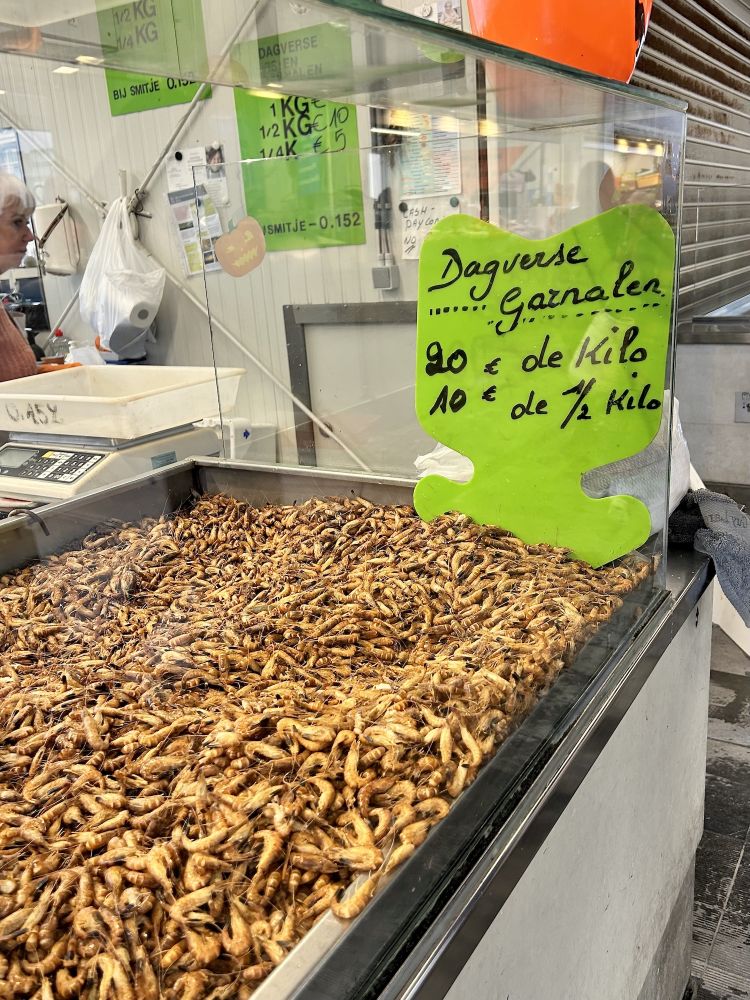
Shrimps at Ostend's Vistrap Market
The market in question is primarily the
Vistrap in Ostend, literally “fish market”.
Willem takes us there early in the morning. There are few stalls, few people; it must be the season. Another reason: «Only boat owners—local fishermen who head out at 4 a.m.—are authorized to sell here». There aren’t many fishermen left, so the market is small, but the product is extraordinary and wonderfully unpredictable. There’s only what was caught alive a few hours before; in fact, the polystyrene boxes are still brimming with life: «Obviously, I come here and never know what will be available for the evening dinner. I adjust the menu based on what I can purchase».
He shops, then suggests we have a coffee («It’s really good») at the Rubens, a charming two-star hotel with a seaside view and a café on the ground floor. «The current owner’s grandfather fished alongside my grandfather’s brother», everything here is about close ties forged on the waves. But the Rubens is still closed, so we head a bit further to try the typical Ostend fisherman’s breakfast: a fresh (and warm) crispy roll filled with plenty of good butter and lightly seared shrimp seasoned with salt and pepper. We savor it at Bakkerij De Cock, a historic bakery: «We’re older than Coca-Cola; we were open during Napoleon’s time», says the owner. That’s not entirely true—the sign dates back to 1855, and the Corsican emperor had been buried in Saint Helena for years.

Fisherman's breakfast in Ostend

Gorgeous breads from Bakkerij De Cock
speaks, a baker of clear French tradition, crafting exemplary loaves in countless types, each better than the last. Then there’s the array of croissants, brioches, and cakes… All excellent. «When I first met the woman who would become my wife—the daughter of the old bakers of
De Cock—our eyes met, and she dropped the baguettes she was holding», or perhaps, more prosaically, holding under her arm: love at first sight, leavening was their destiny.
De Cock remains a go-to spot for passing gourmets, as does the lively brasserie at the
Hotel Du Parc. There, we enjoyed a proper
Dover sole with fries, mashed potatoes, and mixed greens, but also an excellent meat terrine and a spoonful of
keiems bloempje, a local blue cheese that’s soft and delicately flavored (it comes in various forms: with chives, garlic and parsley, or hay, wild garlic, seaweed, summer, and winter herbs).

Belgian oyster lightly smoked, served with seaweed and blueberries
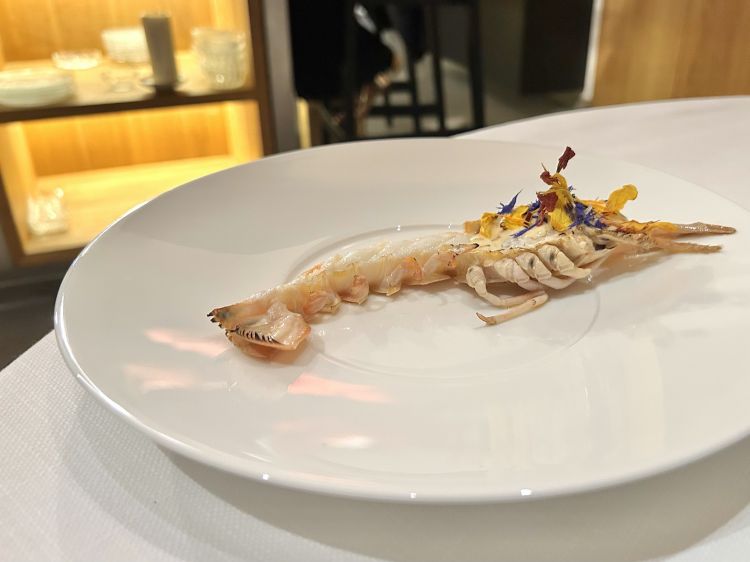
Wood-fired scampi accompanied by a sauce of dried and smoked shellfish (mussels, razor clams), and tomato juice
Lunch was light, in anticipation of dinner at
Willem Hiele’s restaurant. By then, expectations were high—and they were met. The chef’s obsession with top-notch ingredients, as mentioned, is evident. He caresses, grills, and elevates them—
Hiele is a passionate creative. His grilled langoustines with shellfish and crustacean sauce (delicious) and tomatoes (an unnecessary side dish) are savory, indulgent, with pronounced umami. But they’re just the beginning of a journey that shines with an imaginative dish: a patchwork of solidified creams inspired by a
Chaïm Soutine painting. It’s a sort of still life of beetroot, blood orange, nectarine, tomato, basil oil, and sunflower seed caramel. The vegetables are dehydrated, dried, and smoked, then treated like charcuterie. It evoked the flavor tones of a
dolceforte, with naturally more savory notes. Excellent.

A dish Inspired by a painting by Chaïm Soutine (Photo: @chantalarnst)
The evening’s masterpiece, however, had an Italian touch: guanciale from
Riccardo Gaspari’s
SanBrite (exceptional), gifted to
Hiele by the Cortina d'Ampezzo chef during the last edition of
Genesis. It enriched a marvelous scallop with white truffle and mushrooms. The mollusk offers texture, the mushroom gives aroma, and the cured meat is sheer, translucent splendor—the dish of the evening for its depth and complexity.

Scallop with white truffle and SanBrite guanciale

Hare served with Schaerbeek cherries preserved since 2019 in gueuze beer, and black trumpet mushrooms
At the end of dinner, we received the evening’s menus. Indeed,
Hiele improvises daily based on what he finds at the Vistrap, so the dishes listed didn’t match what we tasted. No matter. On the menu card, there’s a message. Translated: “When we dream, we are free because it is precisely where we can exercise our will that we find freedom. And the freedom to think and act is the foundation of our happiness". This, indeed, rings true.
Willem Hiele
Kapittelstraat 71 - Oudenburg, Belgio
+32 (0)58 596221
restaurant.willemhiele.be/en